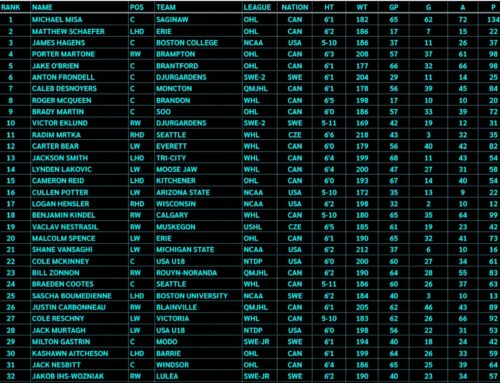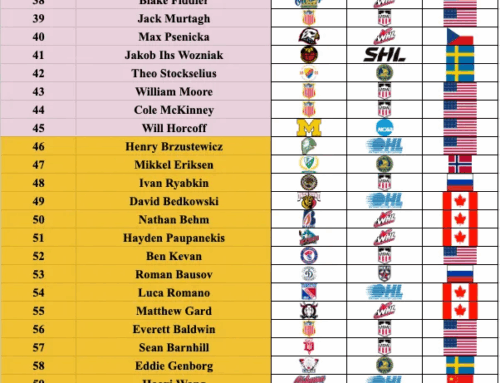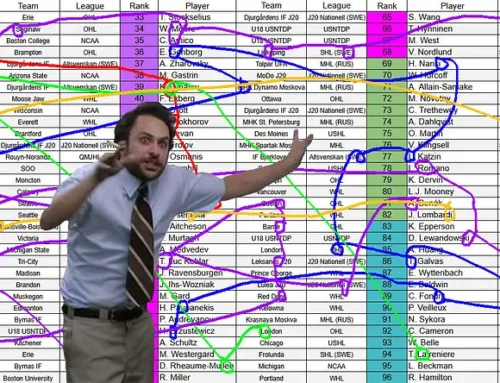Looking Ahead: Hendrix Lapierre
Sam Happi
2019-09-24

Image courtesy of Le Journal de Montreal
***
Hendrix Lapierre (C)
Junior Team: Chicoutimi Saguenéens (QMJHL)
Birthdate: 02/09/2002
Age: 17.60 years
Height/Weight: 5’11″/172 lbs
Handedness: Left
Strengths:
Playmaking:
- Lapierre is a very talented playmaker with high-level vision, creativity, and passing touch.
- Holds a variety of difficult passes in his arsenal – can distribute on the move, off the half-wall, or in just about every conceivable position. Can thread the puck through small, dynamic openings.
- Intelligent distributor can manipulate defenders and passing lanes, accelerating or delaying the tempo to take advantage of momentary openings.
- Extremely deceptive playmaker does a terrific job disguising his passes – the defense doesn’t know where the puck is going until after it leaves his stick.
- Absolutely lethal off the half-wall on the powerplay. Any mistake – a missed assignment, a sleeping defender, or a failure to keep a stick in a passing lane will end with a quick, darting pass from Lapierre and a dangerous opportunity for Chicoutimi.
- Loves to look for lay-up plays with open teammates on the far side of the net. Will disguise the play by beginning to head up or down the wall, then quickly pivot and throw the puck backdoor for an easy finish.
- Likes to present the shooting threat by holding the puck in an active position, freezing the defender and creating the time and space to slide the puck across to a wide open teammate in a shooting area.
Puck Skills:
- Like many playmakers with his level of passing touch, Lapierre has the hands and puck skills to match.
- Talented puckhandler with quick, fleeting hands. Finds lanes, handles the puck well through traffic, able to maintain a versatile, “triple-threat” (to borrow from basketball) position.
- Elusive handler can make defenders miss. His shiftiness is a tremendous asset on zone entries, where he’s able to navigate the blue line, find his way through openings in the opponent’s line defense and enter the offensive zone.
Scoring:
- Doesn’t project to be anything special as a scorer, but Lapierre has plenty of finishing ability from the slot area.
- Shot isn’t overly powerful or heavy, but Lapierre has a quick release and good accuracy.
- Finishing ability adds another dimension to his game – it’s what enables the “present the shot” method of attack that he uses with regularity.
- Averaged just 1.75 shots/game last season, a disappointing result even for a playmaker.
- I don’t think that Lapierre lacks talent as a scorer– it seems more so that he just doesn’t find himself in those opportunities, and that comes ultimately down to his style of play. It’s a somewhat similar situation to Ryan Suzuki last year: a really talented playmaker that has some finishing talent, but he doesn’t shoot the puck or attack the slot enough to score a significant amount of goals.
Intelligence:
- Possesses the vision and ability to read the play necessary for an high-tier playmaker.
- Creative, intelligent attacker can break apart defenses and quickly react to what the opposition is giving him. Does well to recognize and take advantage of gaps in coverage and other defensive mishaps, sliding passes through lanes to teammates in scoring positions.
Two-way ability:
- Lapierre owns a refined two-way game – so refined, actually, that Craig Button compared him to Patrice Bergeron and Aleksander Barkov.
- The centre plays a responsible defensive game, assisting his defensemen down low and ensuring that the breakout goes smoothly through consistent support from the middle of the ice.
Weaknesses:
Skating:
- Lapierre’s skating projects as average to slightly above – which isn’t terrible in the grand scheme of things, but really stands out in this year’s extremely talented top 15.
- Lapierre can be a little sluggish – his top speed is rather average and his first steps can be slow and inconsistent.
- On a more positive note, Lapierre’s edges are very refined. It’s what, along with his puck skills, enables him to be so shifty on entries and in the offensive zone.
Even-Strength Production:
- Just 55.88% of Lapierre’s points came at even-strength, a very low percentage. That was one of the lowest marks of all 2020-eligibles in the CHL last season. In comparison, guys like Alexis Lafreniere, Quinton Byfield, Marco Rossi, and Cole Perfetti are all upwards of 65%.
- Looking purely at even-strength primary points per game, Lapierre ranks 16th among those CHLers. That’s a far cry from his 7th best rank looking at total points per game.
Summary:
Lapierre is a highly gifted playmaker that can create offence for his teammates in a wide variety of ways. His vision is outstanding, and he does an extremely impressive job completing difficult passes. His intelligence and ability to pick apart defenses is among the best in the draft, and that skillset should transition well to better competition at the NHL level.
Looking purely at ceiling, I can see an argument for the Quebec-native as high as the top 7. Unfortunately, a few of his weaker points could limit his odds at realizing that upside.
His skating is the technical issue, but the real problem is his reliance on the man advantage for a good portion of his point production. Let’s dive into that disparity between even-strength and 5v4 production.
To start: does this split even matter, or should we just be looking at all-situations numbers with no regards to game state? Logically, you’d think it would– it’s more difficult to produce at even-strength than when you have a numerical advantage, so those 5v5 points should be worth more.
We’re looking at this in the context of trying to project Lapierre’s NHL future, so naturally, we should look at how different kinds of production translate to the NHL level.
We’re going to simplify this by moving to primary points– removing some of the noise of secondary assists from the equation. Looking at this chart, we can see that even-strength primary points are roughly twice (0.25 vs 0.12) as predictive of future NHL scoring than the powerplay variety.
We can use our findings here to form a basic weighted metric to evaluate Lapierre’s specific situation. We’ll use a 2:1 weighting system, where EV points are worth twice as much as those that come on the powerplay.
By total primary points per game, Lapierre ranks in the 98th percentile of 2020 eligible CHLers. Looking at our weighted metric, he appears in the 95th percentile. That doesn’t seem like a major difference, but Lapierre goes from being the fifth best draft eligible CHLer under P1/GP to the ninth best. When we’re talking about a potential top 10 pick in Lapierre, that four player difference is quite meaningful.
We still have a full season to play before the 2020 NHL Draft, so Lapierre has 68 QMJHL games over the next several months to improve his even-strength production and bury this concern. But if Lapierre can’t, it should impact his draft stock. Will a team really want to use a top 10 pick on a powerplay specialist?
If he can put this worry to rest, Lapierre projects as a capable top-six centre that will impact the game in all three zones. If his reliance on the man advantage continues, he may be more fit for a lesser role at even strength while still receiving top powerplay duties. There’s a lot to like either way, but one of those options is a lot more versatile and valuable than the other.
Sam Happi







